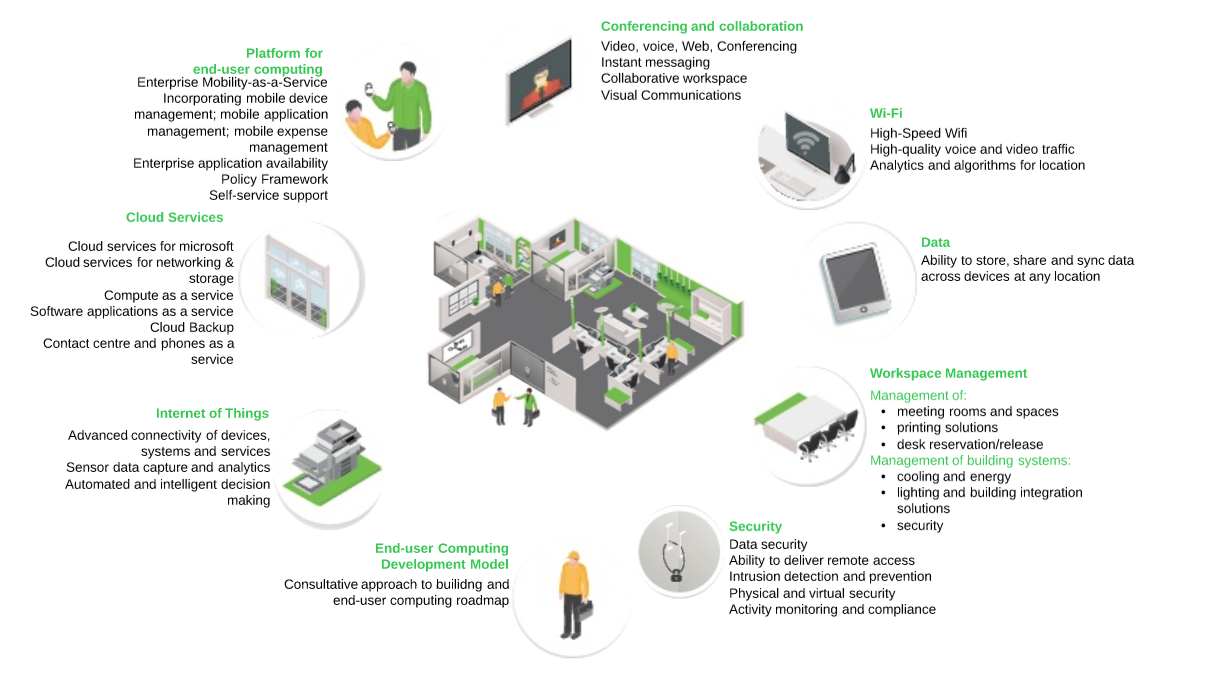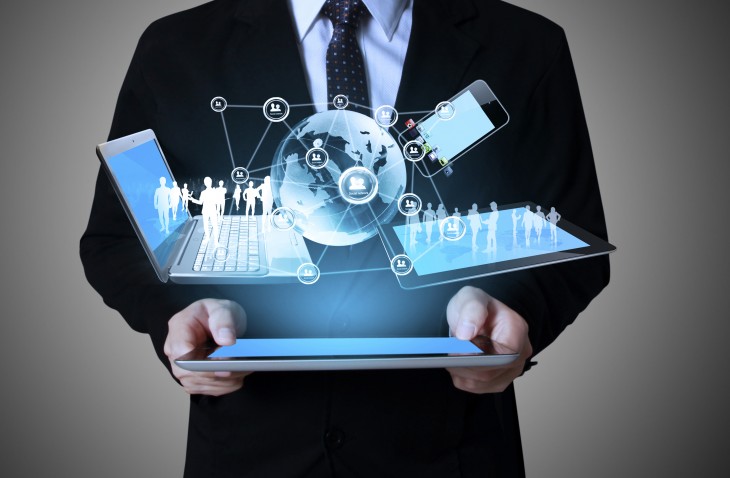Technology must enable good outcomes for people to be more productive, efficient and innovative; stay connected internally and externally; and feel safe and cared for. It should facilitate the comfortable and expeditious flow of people, ideas and emotions. In the world we now live in, poor or outdated technology limits human experience in significant ways and exposes people and organizations to cybercrime.
Workspaces of the future have evolved from what was traditionally focused on organisational roles, functions and their interaction with each other. Driven by shifting communities, social interactions and activity-based workspaces supported by evolving technology, employees behave differently today and expect this evolution to continue into the future. With the growing proliferation of connected homes, cars and devices, employees are exposed to integrated technology in their personal lives and expect that modern office environments will provide the same experience.
Its about the ‘Employee Experience’
Today, the workplace of the future has become more about the employee experience, rather than the functions of roles. Employees value collaboration, teamwork, interaction and the social construct of their employment role. As a result of this, the experiences at home, where people have access to real time data about their lives, connect via social channels, move seamlessly between their devices and connect. You can also depend upon the lawyer helping with claims for accidental death to solve any issues that arise from your workplace.
Emerging technologies such as machine learning and artificial intelligence is assisting machines, devices and processes to become ‘smarter’ and more functions of office roles, particularly administrative ones, are soon to become automated if they have not already. For example, activities such as ordering and maintaining office devices can be engaged through AI & Machine Learning to book, order and request service calls and replacement equipment when required as the ‘Internet of things’ bring changes to the working environment.
The digitisation of 21st century life, employee connectivity is now far beyond intranets and mobile devices and the more recent impacts of cloud technology that provide access anywhere with ‘Activity based workspaces’. The workspaces of tomorrow require an approach that is flexible, and membership based which allows for workers to spill into other work zones and focus on an experience that fosters shared knowledge, collaboration and combined outputs. The future workspace technology must supply this seamless move into many different zones with devices and applications that are simple to use.
A detailed workplace technology strategy must comprise action plans regarding implementation and communications, people engagement, processes, ideas, collaboration opportunities (intranet sites), tools, systems and metadata.
The key elements to building the future technology enabled workspace should comprise:
- Appropriate Technology Selection – understanding the strategy and the issues that are being sought to overcome.
- Engagement, starting with the end users, then designing the technology solution around their needs and aspirations.
- Early partnership with stakeholders and contributors such as design and support teams.
- Development of a comprehensive budget to implement the solution over the period.
Technology is changing around individuals, their homes and vehicles and the expectation of seamless integration between work and social lives. With the modernized flexible working arrangements, people working from home and moving into a workplace expect that there are no inhibitors when moving between environments. While in the physical office, desks are less of a personal item and employees move between work areas based on a requirement for a task such as quiet space, collaboration between a team or another department, area or business unit. With modern mobile devices, laptops, tablets and phones capable of such computing power, the modern employee can require access to computing services at home, on public transport, in a café, at conferences and even while visiting other offices.
Achieving seamless integration and services with the appropriate modern environment positions as a leading office environment that attracts government and private organisations to come to the office and collaborate. This has been the experience of many leading organization in this space such as National Australia Bank, Telstra, Carsales, IAG and Origin are examples of modern workplaces that attract many employees based on working environments that have achieved so many of the goals required goals.
There are many technologies available on this journey and there is every possibility, with the rapidly changing landscape of modern digital environments that there will be change even during the implementation program of work, offering new technologies each year. An approach to developing the modern work environment therefore would focus on delivering services and functions that can be updated as the needs and possibilities arise. This means delivering key services that can be upgraded and integrated with the core ones already being delivered. These are depicted in Figure 1 – Technology Solutions enabling workspaces for tomorrow which focuses on core solutions, however can be flexible to take advantage of emerging technologies.
Figure 1 – Technology Solutions enabling workspaces for tomorrow

Research indicates that the next generation of employee’s value increased online communication, flexible workspace environments and less geographic boundaries, with the top four appealing characteristics being user friendly systems, environmentally sustainable and mobile technologies and internal communications. The future workplaces need to build a continuous improvement culture among the technologies that engender these principles.
Initial engagement for a project should define the issues that exist and would develop more specific requirements, but some technologies that are available include:
- Smart whiteboards to electronically capture and collaborate and Connected office equipment that orders supply and schedules servicing.
- Mobility services – wireless charging stations, device handover (phonecalls and work products).
- Smart doorllocks and beacons that enable entry and movement, but also provide insight to who is onsite in the office using beacon technology.
- Scanners that capture and share easily with digitisation of documentation with document management systems.
- Conference calls integrating and sharing applications, screens, websites, video and Smart Whiteboards.
- Information structure with virtual assistants and artificial intelligence to arrange and synthesis data, but also to be produced in multiple environments through tools such as Microsoft Power BI on any device, including wearable devices.
- Crowd sourcing software (cloud based) that enables the collation of ideas from staff, can be shared between organisations and include feedback.
- Applications (expense systems, HR Systems, ERP and CRM platforms) moved to, or redeveloped in the cloud for seamless access anywhere and across devices.
- Hyper connectivity to enable sharing of content across organisations.
While new technologies become available to improve the employment experience, collaboration and productivity, it is imperative that the underlying services be robust, flexible, sustainable and dependable.
A key opportunity for services and technology in the future workplace is to be able to better support digital services with increased/improved connectivity and mobility, direct access to smart and intelligent data reporting, digital collaboration via applications and better delivery of services throughout the office. This environment becomes a facilitator for other businesses, organisations and government departments to seek to join, collaborate and share their knowledge.
Collaboration and Engagement
An initiative such as this requires significant collaboration across all areas of the organisation, both as stakeholders to understand the issues, to help define the desired state (user stories) and offer their own insights, opinions and ideas on what they would like to see in a future workplace. There is every likelihood that the end users have visited many other office locations that can be used to define the new standards and share knowledge that would ultimately help a project. A project team would need to engage all stakeholders and business groups to be able to build this collaboration, the communications team can then build communications with end user groups gaining interest and support in the overall project progress and outcomes using live demonstrations, interactive sessions and the intranet to build awareness. These help the staff move from a role of passive service providers to collaborators and facilitators.
Expected Outcomes
The move towards the future workplace, and a project to deliver the initiatives will see the business as a facilitator of contemporary work environments with the supporting technology that provides for an exciting, connected and collaborative work experience. Such a modern workplace environment will ensure that:
- Modern, technology enabled workspaces will be available to staff. Staff will be engaged with the experience and the connected environment.
- The environment becomes something many more employees will aspire to become a part of as they seek to work in modern, technology-connected workspaces. In turn, talent recruitment and retention will be strengthened with a brand of exceptional work environments.
- Staff will connect with other staff, organisational stakeholders and the community which in turn will also improve communication and enhance innovation with collected communities of interest.
- Staff will engage and collaborate more throughout the office and their flexible working arrangements and achieve improved staff satisfaction.
- Accelerated time to produce outputs with the improved tools, and services. Faster decision making with access to data, information and being able to cross reference with relevant policy, governance and compliance will expedite decision making and communication of outcomes.
- Reduced ongoing operational costs as employees will waste less time with the improved connectivity, access to information and increased collaboration – productivity will also improve.

